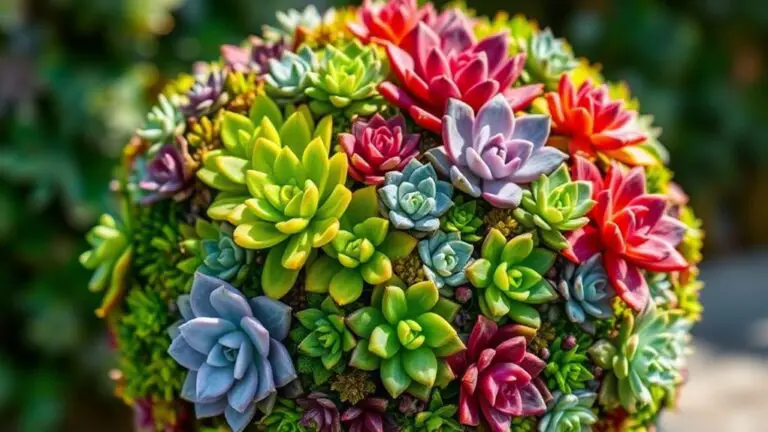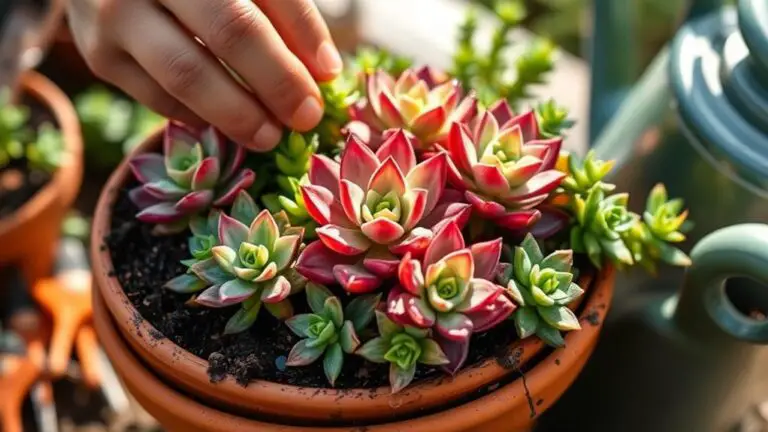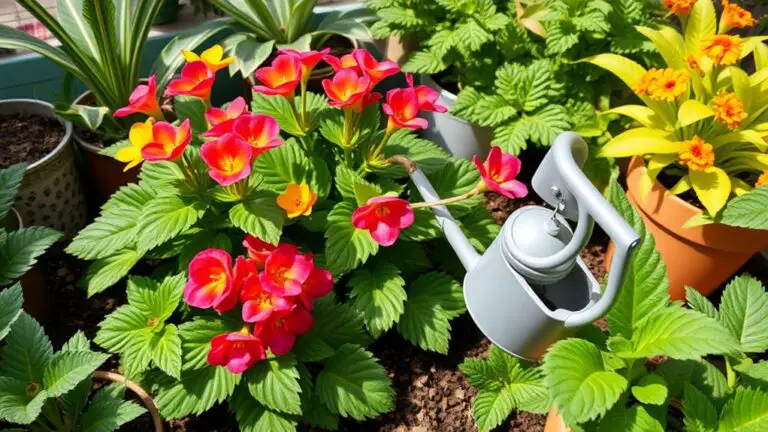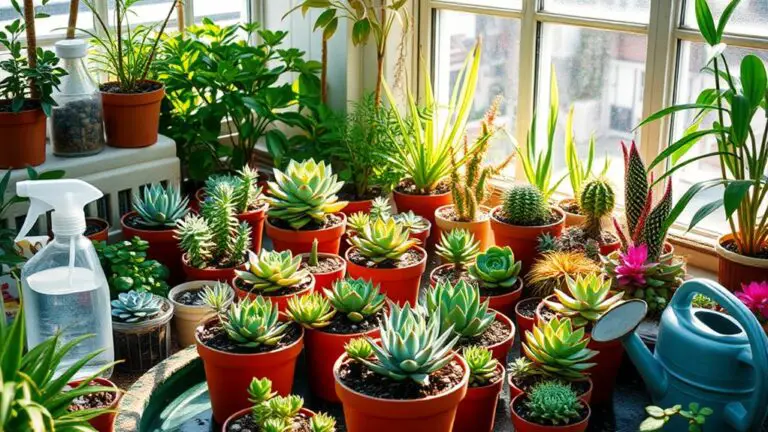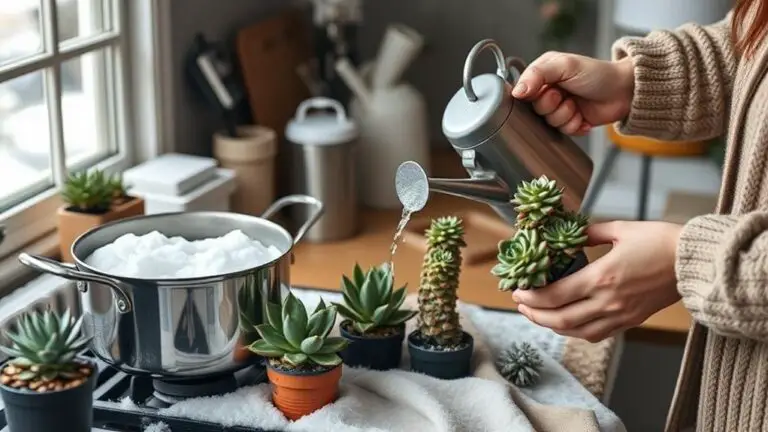10 Essential Steps to Pothos Plant Care
Caring for a Pothos plant is straightforward when you know the essential steps, starting with choosing the right location and understanding its light requirements. You'll want to position your Pothos in bright, indirect light to keep it thriving. Don't forget, correct watering techniques and ideal soil conditions are vital to prevent root rot. We'll also touch on maintaining the perfect temperature and humidity, how to prune for denser growth, and effective propagation methods. Curious about repotting essentials or tackling common problems? Let's explore how to keep your Pothos healthy and vibrant.
Choosing the Right Location
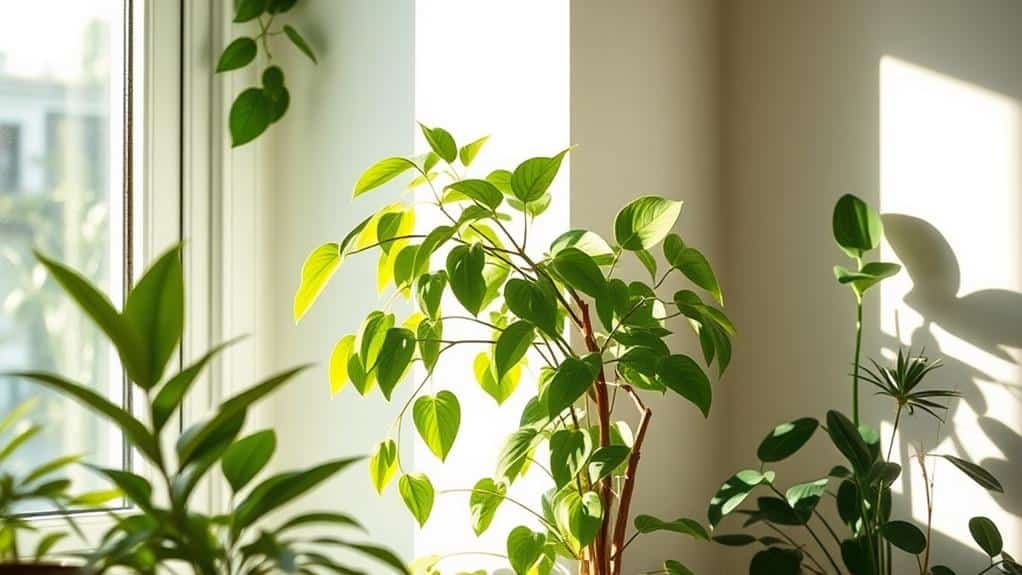
Choosing the right location for your Pothos plant is essential for its health and vibrant growth. This plant thrives in bright, indirect light, making a spot near a window with filtered sunlight perfect for ideal growth and variegation. Variegated varieties, like Marble Queen, need more light to keep their beautiful coloring.
While Pothos can adapt to low-light conditions, brighter spots are better for these types. When placing your Pothos, avoid direct sunlight. Direct rays can scorch the leaves, causing them to turn brown at the edges.
Also, consider the temperature. Pothos plants prefer temperatures between 65°F and 75°F. It's important to choose a location that avoids drafts or extreme temperature changes, which can stress the plant.
Humidity is another key factor. Pothos plants like humidity levels around 40-60%. Bathrooms or kitchens, where humidity tends to be higher, can be excellent locations for your plant. These spots can help maintain the moisture levels Pothos love.
Light Requirements
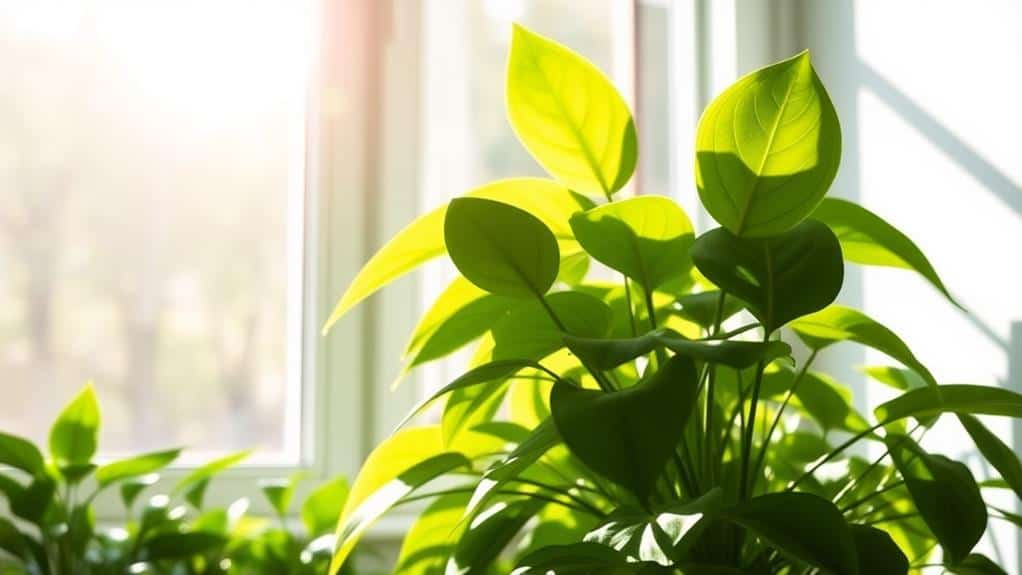
Understanding the light requirements for your Pothos plant is key to ensuring it thrives. Pothos plants love bright, indirect light but can also do well in medium to low light conditions. This makes them perfect for different indoor spots.
If you have variegated varieties like Marble Queen, remember they need more light to keep their unique colors. Without enough light, these plants can turn mostly green.
It's important to avoid placing your Pothos in direct sunlight. Harsh sunlight can scorch the leaves, causing them to burn and get damaged. Instead, aim for filtered light. A great place for your Pothos is near a sunny window where the plant gets plenty of light but not direct sun rays.
In lower light areas, your Pothos might grow more slowly and have smaller leaves. However, it will still be a resilient and hardy plant.
Watering Techniques

When it comes to watering your pothos, you should wait until the top 2 inches of soil feel dry.
Be sure to water thoroughly until you see excess water draining from the bottom.
Keep an eye out for drooping leaves, as this can be a sign that your plant needs more frequent watering.
Proper Soil Moisture
For ideal Pothos plant care, it's important to manage soil moisture effectively, ensuring the top 2 inches of soil dry out completely between waterings. This step helps prevent root rot and promotes healthy growth.
When you water, make sure to water thoroughly, allowing the excess to drain out of the pot's drainage holes. This prevents the soil from becoming too soggy, which can harm your Pothos plants.
Using a well-draining potting mix, like Miracle-Gro® Indoor Potting Mix, is vital. This type of soil helps retain the right amount of moisture while allowing excess water to escape, creating a healthy environment for the roots to develop.
Remember, pothos plants can tolerate missing a watering for up to a week, but regular monitoring is key to keeping them healthy.
Adjust your watering frequency based on the season. During the growing season, which is spring and summer, you'll need to water more often. In fall and winter, you can reduce the frequency as the plant's growth slows down.
Always allow the top 2 inches of soil to dry before the next watering. This simple practice will keep your Pothos plants thriving and prevent common issues like root rot.
Signs of Overwatering
Maintaining proper soil moisture is essential, but it's equally important to recognize the signs of overwatering. Overwatering can harm your pothos plant and lead to problems like root rot. One of the first signs is yellow leaves. If you notice your pothos leaves turning yellow and the soil feels soggy, it's likely getting too much water.
Another sign to watch for is drooping leaves. While drooping can mean underwatering, if the soil is damp, it indicates overwatering. Soggy soil is a big red flag. When you water every time the soil looks wet, you're not giving it a chance to dry out. The top 1-2 inches of soil should be dry before you water again.
Inspect the roots if you're unsure. Healthy roots are firm and white, but overwatered roots turn mushy and black. To prevent this, use pots with drainage holes. These holes let extra water escape, stopping it from pooling at the bottom and causing rot.
Taking care of your pothos means knowing when it's had too much water. By recognizing the signs of overwatering, you can adjust your watering habits and keep your plant healthy and happy.
Ideal Watering Frequency
Understanding the ideal watering frequency for your pothos plant is essential to its health and longevity. You'll want to let the top 2 inches of soil dry out completely between waterings. This prevents root rot and keeps your plant healthy. Pothos can go about a week without water, thanks to its drought-resistant nature, but regular monitoring is key to guarantee peak growth.
When it's time to water, do it thoroughly. Make sure excess water drains out of the pot to avoid waterlogged conditions, which can harm the roots. Always use pots with drainage holes to facilitate proper drainage. If you notice drooping leaves, it's a sign your plant needs immediate watering.
Here's a quick reference table to help you monitor your pothos watering needs:
| Condition | Action |
|---|---|
| Top 2 inches of soil dry | Water thoroughly |
| Drooping leaves | Water immediately |
| Soil still moist | Wait before watering again |
Ideal Soil Conditions
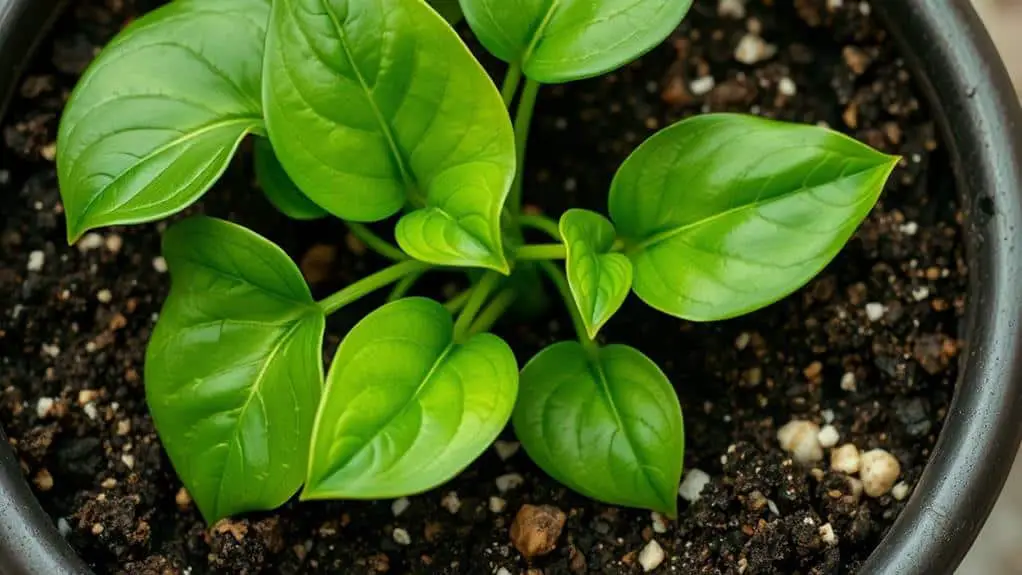
When it comes to keeping your Pothos healthy, choosing the right soil is key.
You'll want a well-draining potting mix, ideally slightly acidic with a pH of 6.1 to 6.5, to promote strong root growth.
Remember to check the soil moisture regularly and repot every 1-2 years to keep your plant thriving.
Choose Well-Draining Mix
For your Pothos plant to thrive, choosing a well-draining potting mix is vital. This type of mix helps prevent root rot, which can be fatal for your plant. A suitable option is Miracle-Gro® Indoor Potting Mix.
You should aim for a soil that's slightly acidic, with a pH range of 6.1 to 6.5, to support healthy growth and provide the right environment for your Pothos.
To enhance drainage and aeration, incorporate materials like perlite or lava rocks into the mix. These additions will help guarantee that excess water can drain away, preventing water saturation.
When you're repotting your plant every 1-2 years, use fresh potting soil to guarantee your Pothos receives the necessary nutrients for prime growth conditions. This regular repotting helps maintain a nutrient-rich environment, essential for your plant's health.
Always use a pot with drainage holes. These holes allow water to escape, promoting healthy root development and reducing the risk of root rot.
With the right soil and proper care, your Pothos will flourish, giving you a beautiful, thriving plant to enjoy.
Monitor Soil Moisture**
After selecting the right potting mix, the next step is to monitor soil moisture to keep your Pothos healthy. You should allow the top 2 inches of soil to dry out completely between waterings to prevent root rot. During the growing season, aim for consistent moisture, but be careful not to overwater. Overwatering can cause black spots on leaves and sudden leaf collapse.
To guarantee the best conditions for your Pothos, use a well-draining potting mix with slightly acidic pH levels between 6.1 and 6.5. This helps promote healthy root growth. Checking the soil regularly, especially during warmer months, will help you prevent it from becoming too dry or overly saturated. Remember, pots with drainage holes are essential to let excess water escape, preventing root problems.
Here's a quick guide to help you:
| Task | Frequency |
|---|---|
| Check soil dryness | Every 3-4 days |
| Water if top 2 inches dry | When needed |
| Use well-draining mix | Always |
| Guarantee drainage holes | Always |
Temperature and Humidity
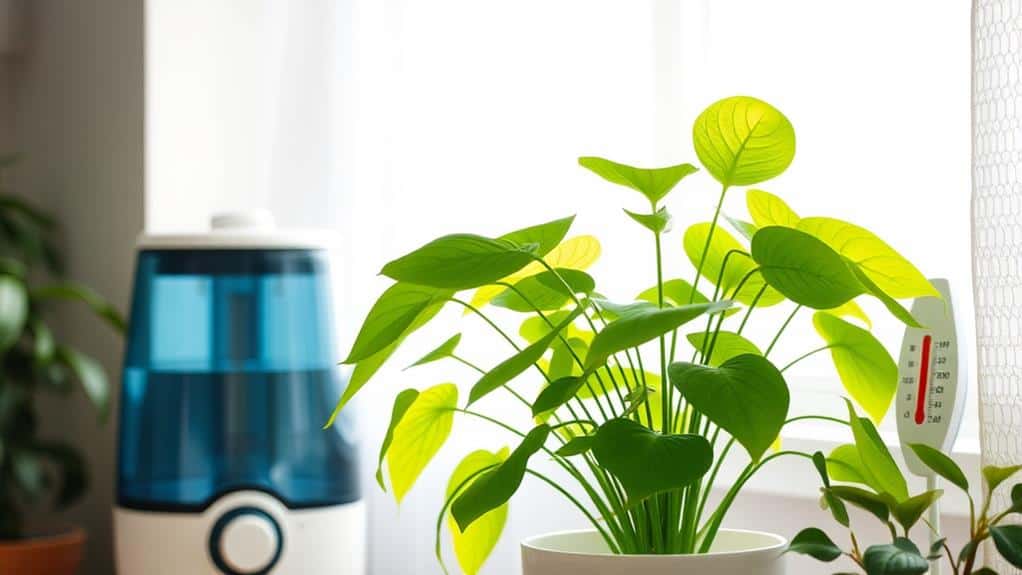
Maintaining the right temperature and humidity is essential for the healthy growth of your pothos plant. Pothos prefers an ideal temperature range of 65°F to 75°F (18°C to 24°C). It can handle cooler conditions but shouldn't be exposed to temperatures below 50°F (10°C). If you keep your pothos within this range, it'll thrive and grow well.
High humidity, ideally between 40% to 60%, is also vital. Pothos can adapt to the lower humidity levels found in most indoor environments, but higher humidity helps it flourish. Placing your pothos in a bathroom can take advantage of the naturally higher humidity there. If that's not possible, consider using a humidifier or placing a tray of water near the plant to boost humidity levels.
Avoid sudden temperature fluctuations or drafts, as these can stress your pothos, leading to yellowing leaves or stunted growth. Make sure to place your plant away from air vents, windows that frequently open, or doors that lead outside to prevent these issues.
Fertilizing Practices
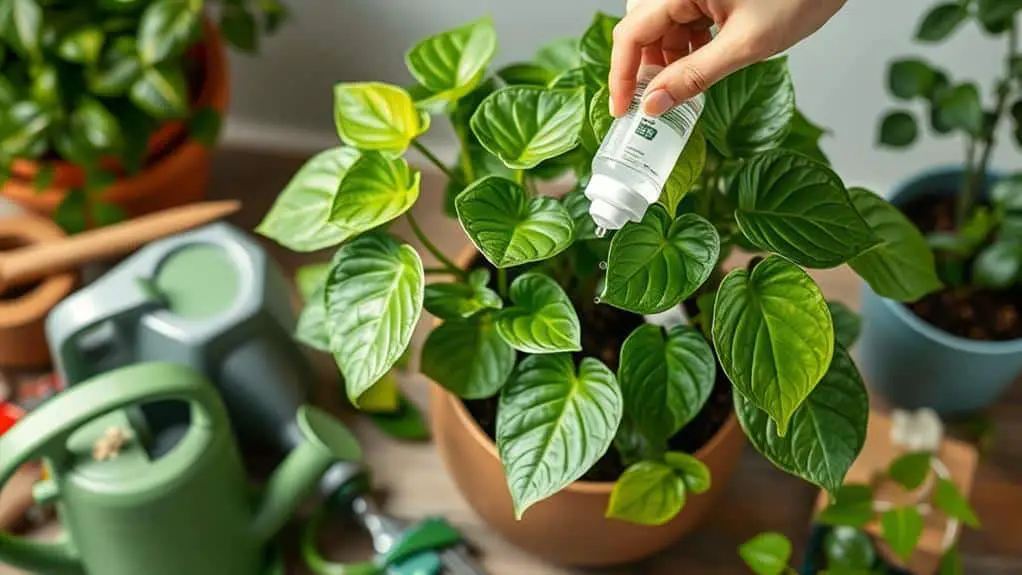
Fertilizing your pothos plant correctly guarantees it gets the essential nutrients for vigorous growth and lush, green foliage. To achieve robust growth, use a balanced, water-soluble fertilizer every 1-3 months during the spring and summer. This keeps your plant healthy and thriving.
Here's a quick guide:
| Season | Fertilizing Frequency |
|---|---|
| Spring | Every 1-3 months |
| Summer | Every 1-3 months |
| Fall | Avoid fertilizing |
| Winter | Avoid fertilizing |
Using a diluted fertilizer solution, like Miracle-Gro® Indoor Plant Food, is perfect because it provides the necessary nutrients without overwhelming your pothos. Be certain to follow the package instructions for the correct dosage. Over-fertilization can lead to leaf burn, which you definitely want to avoid.
During the fall and winter months, your pothos' growth slows down, so it doesn't need as much nutrition. Skip the fertilizer during these seasons.
Keep an eye on your plant's growth and health. If it looks sluggish, you might need to increase fertilizing frequency. On the other hand, if you notice any signs of stress, decrease it to prevent over-fertilization. This balanced approach guarantees your pothos stays vibrant and lush year-round.
Pruning and Trimming
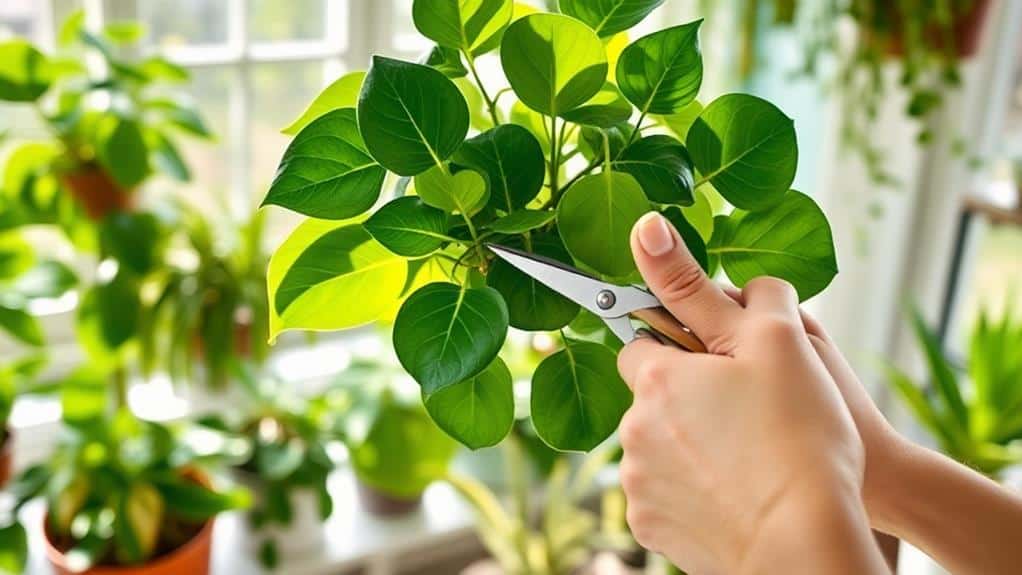
While proper fertilizing practices keep your pothos nourished, pruning and trimming play a key role in enhancing its aesthetic appeal and structure. By regularly pruning and trimming, you'll encourage healthier growth and make your plant more visually appealing.
Here's how you can keep your pothos looking its best.
First, always use sharp, sterile tools for pruning. Make cuts just below a node to guarantee regrowth and leave at least two leaf nodes on the stem. Regular trimming is best done during the growing season, ideally in spring and summer. Avoid pruning during dormancy to prevent stressing your plant.
Trim back scraggly vines to a node to encourage rejuvenation and denser foliage. This not only makes your pothos look fuller but also healthier.
Don't forget to remove yellow leaves by pinching them off at the base. This simple step can greatly improve your plant's appearance and promote healthy growth.
Here are some key tips:
- Use sharp, sterile tools for clean cuts.
- Prune during the growing season, avoiding dormancy.
- Trim scraggly vines to a node for denser foliage.
- Remove yellow leaves to maintain a healthy look.
With these steps, your pothos will thrive and stay beautiful!
Propagation Methods
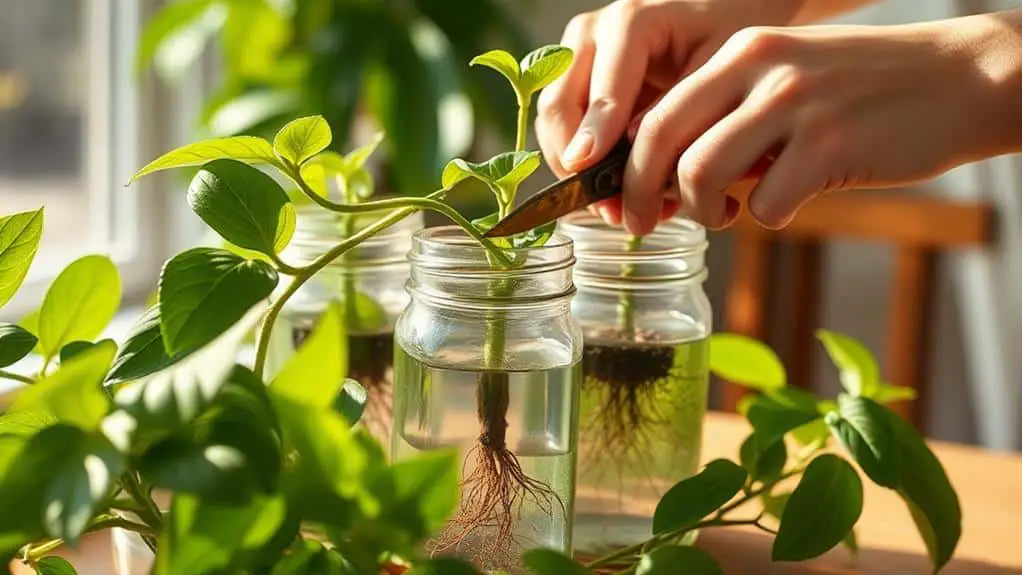
Let's explore how you can propagate your Pothos plant using water or soil.
For water propagation, cut a healthy stem with at least three leaves and place it in water, ensuring the leaves stay above the waterline.
If you prefer soil propagation, plant the cutting in moist potting soil, keeping it damp until roots establish.
Water Propagation Steps
Propagating a Pothos plant in water is a simple and rewarding process that allows you to multiply your greenery. Follow these water propagation steps to guarantee success:
- Select a healthy stem with at least three leaves and cut it diagonally just below the lowest leaf node.
- Place the cuttings in water, guaranteeing the cut end is submerged while the leaves stay above the water to prevent rot.
- Change the water every 1-2 weeks to keep it fresh and oxygenated, which promotes healthy root development.
- Provide indirect sunlight and watch as roots form over 2-4 weeks. Once they reach 2-4 inches, transfer the cutting to soil.
Start by choosing a healthy stem with at least three leaves. Make an angled cut below the lowest leaf node to prepare your cutting.
Place the cutting in a jar or glass filled with water, making sure the cut end is submerged while the leaves remain above water to avoid rot.
Change the water every 1-2 weeks to keep it fresh and oxygenated, which will help in healthy root development.
As roots form over the next 2-4 weeks, guarantee the jar gets indirect sunlight.
When the roots are 2-4 inches long, transplant the cutting into soil and keep the soil evenly moist.
Soil Propagation Techniques
Soil propagation techniques for Pothos plants offer a straightforward way to expand your indoor garden.
Start by taking a stem cutting that's at least 2-3 inches long, making sure it includes multiple leaves. Cut just below a node to give your cutting the best chance to root.
Next, place the cutting in a pot filled with well-draining potting mix, which could include perlite for extra drainage. Water the soil thoroughly to help settle it around the cutting.
Keep the soil consistently moist, but be careful not to let it get soggy. Let the top inch dry out between waterings to avoid root rot.
Position the pot in a spot with bright, indirect light. This light will encourage root growth without stressing the cutting. Direct sunlight can be too harsh and might cause wilting.
You'll know you're succeeding when you see new leaf growth and the cutting resists wilting. This usually happens within 4-6 weeks.
Repotting Essentials
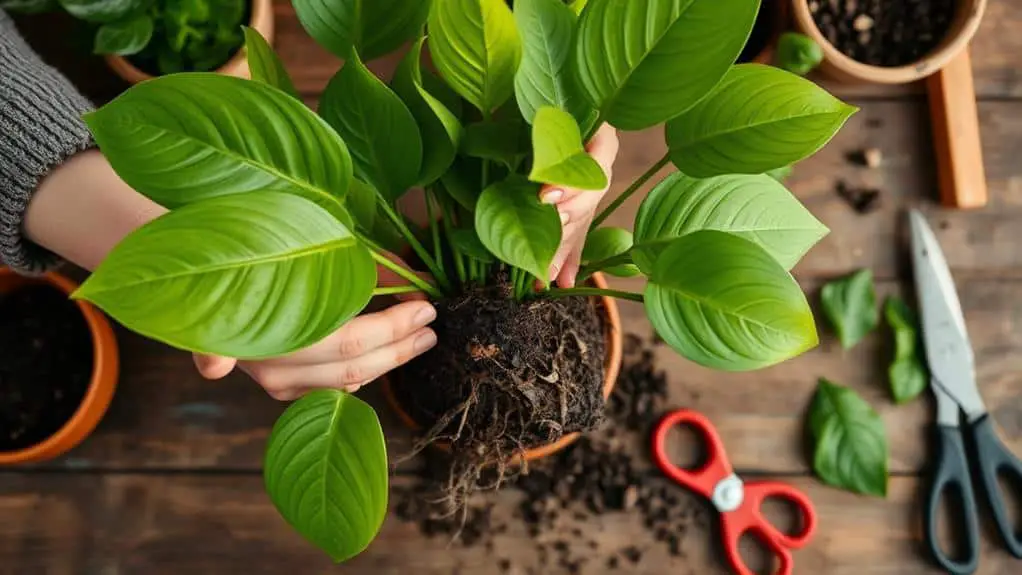
Repotting a Pothos plant is an essential task to guarantee its continued health and growth. You should repot your Pothos every 1-2 years or when the roots fill the pot. Signs indicating it's time to repot include drooping leaves or root crowding.
Spring is the perfect time for repotting since it coincides with the active growth season.
Here's a simple guide to help you:
- Choose a new container: Pick one that's 1-2 inches wider than the root ball and has drainage holes to prevent waterlogging.
- Select the right potting mix: Use a well-draining potting mix, such as a lightweight blend with perlite or lava rocks, to enhance drainage and reduce root rot risks.
- Repot carefully: Gently remove the plant from its current pot, place it into the new container, and fill around the root ball with the new mix.
- Water thoroughly: After repotting, water the plant thoroughly to help it settle into its new home and aid in recovery.
Common Problems and Solutions
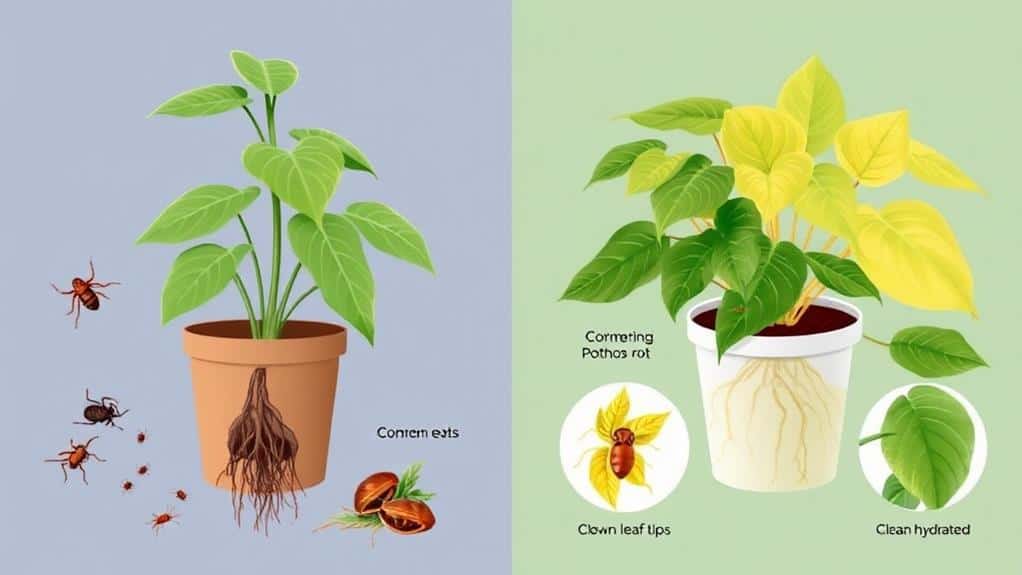
Taking care of a Pothos plant can be straightforward, but several common issues might arise that require your attention.
Overwatering is a frequent problem, leading to root rot. Look out for black spots on leaves and sudden leaf collapse. To avoid this, let the top inch of soil dry out between waterings.
On the flip side, underwatering causes drooping leaves and brown edges. If you notice these signs, increase your watering frequency and guarantee the soil moisture is adequate.
Yellowing leaves can signal root rot or disease. Check if the soil is too damp. If it is, consider repotting your Pothos into fresh, well-draining soil.
Insufficient light can cause variegated leaves to turn solid green. Move your plant to a spot with bright light but indirect sunlight to fix this.
Regularly monitor your plant's soil moisture and overall health. This helps you catch and address issues early.
If you see any of these problems, don't panic. Adjust your care routine accordingly, and your Pothos will thrive.
Frequently Asked Questions
How to Properly Care for a Pothos Plant?
You should place your Pothos in bright, indirect light, water every 1-2 weeks, and let soil dry between watering. Fertilize monthly in spring and summer, prune regularly, and repot every 1-2 years for best results.
What Do Pothos Need to Thrive?
Pothos need bright, indirect light, but can handle low light. Keep temperatures between 65°F and 75°F, use well-draining soil, let the top inch dry out, fertilize monthly in spring and summer, and prefer high humidity.
Should I Mist My Pothos Plant?
You can mist your Pothos plant, but it's not necessary. They adapt well to average room humidity. If you choose to mist, do it sparingly and in the morning to avoid any fungal issues.
How Can I Make My Pothos Grow Better?
To make your Pothos grow better, place it in bright, indirect light, water when the top 2 inches are dry, feed monthly during growth seasons, prune regularly, and repot every 1-2 years for peak health and growth.
Conclusion
You've got all the know-how to keep your Pothos plant thriving! Remember to place it in bright, indirect light and water when the topsoil is dry. Use well-draining soil, keep temperatures between 65°F and 75°F, and don't forget to fertilize. Prune for a fuller look and propagate with stem cuttings. Watch for any signs of stress and adjust your care as needed. With these steps, your Pothos will stay healthy and beautiful. Happy gardening!


